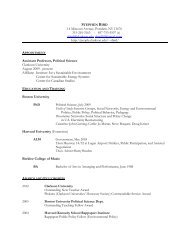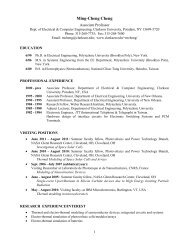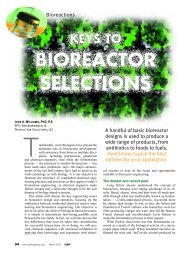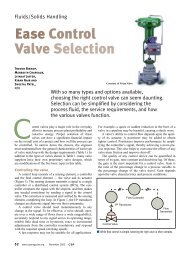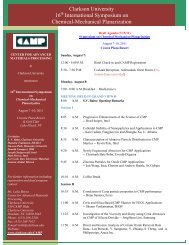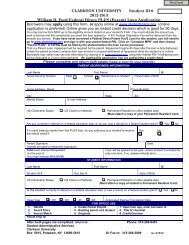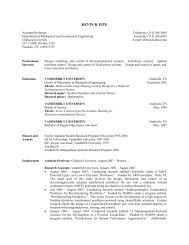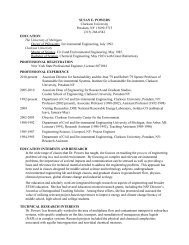Size Depressurization and Relief Devices for Pressurized Segments ...
Size Depressurization and Relief Devices for Pressurized Segments ...
Size Depressurization and Relief Devices for Pressurized Segments ...
Create successful ePaper yourself
Turn your PDF publications into a flip-book with our unique Google optimized e-Paper software.
is the combustion of flammable or combustible<br />
fluids spilled <strong>and</strong> retained on a<br />
surface. The ventilation- <strong>and</strong> fuel-controlled<br />
fires are related to the stoichiometric<br />
ratio of air-to-fuel (Figure 1).<br />
Figure 1 is general <strong>for</strong> both a jet <strong>and</strong> a pool<br />
fire; the difference being a higher flux <strong>for</strong> the<br />
jet fire. For a pool fire, the API fire (4) is illustrated<br />
as the lower, dashed line to the right.<br />
Note that in the equation API RP 521 uses, increasing<br />
the area reduces the flux. The dashed<br />
lines represent the average heat flux. However,<br />
when studying the total volume of a fire,<br />
any point on the continuous curve will be<br />
found. A ventilation-controlled fire is to the<br />
left of the peak heat-flux in Figure 1 at a stoichiometry<br />
of < 1. The fuel-controlled fire is to<br />
the right, i.e., the stoichiometry is > 1.<br />
The fire equation<br />
The heat flux absorbed by a segment from a fire, q absorbed<br />
(kW/m 2 ), can be modeled as:<br />
4 4<br />
qabsorbed = κα ( segmentε fireT fire −εsegmentT<br />
segment )+<br />
h× T −T<br />
( gas segment )<br />
The absorbed heat flux will be reduced with increasing<br />
segment temperature, <strong>and</strong> a steady-state segment temperature<br />
will be reached when the heat influx from the fire<br />
equals the heat outflux from the segment.<br />
The view factor, which is not included in Eq. 1, is a<br />
scaling factor <strong>for</strong> the radiative terms. The view factor is<br />
≤ 1.0. It equals 1.0 when the segments that absorb radiation<br />
“see” nothing but an optical, thick flame. Calculation of<br />
view factors is difficult <strong>and</strong> a conservative assumption involves<br />
use of a view factor of 1.0, which results in Eq. 1.<br />
The incident heat flux is calculated by setting α segment =<br />
1.0 <strong>and</strong> disregarding the segment emissivity term. The<br />
“initial incident heat flux” from a fire is<br />
calculated by setting α segment = 1.0 <strong>and</strong><br />
T segment equal to the normal operating temperature<br />
(of the cold segment).<br />
Input to the fire equation<br />
The different terms in the fire equation<br />
are combined to achieve the required initial<br />
heat fluxes. Tables 1, 2 <strong>and</strong> 3 suggest<br />
values to be used. The segment absorptivity<br />
<strong>and</strong> emissivity in Eq. 1 are normally<br />
equal <strong>and</strong> depend upon the nature of the<br />
surface. Typical values are 0.7–0.9. A<br />
value of about 0.8 is typical <strong>for</strong> oxidized<br />
surfaces. The value will change as more<br />
Heat Flux<br />
(1)<br />
Globalventilationcontrolled<br />
1.0<br />
Local fire<br />
Global fuel-controlled<br />
Stochiometric Ratio<br />
Open-fuel-controlled<br />
pool fire<br />
■ Figure 1. The heat flux from a fire <strong>and</strong> its relation to the stoichiometric ratio.<br />
<strong>and</strong> more soot attaches to the surface. For more on absorptivity<br />
<strong>and</strong> emissivity, see Ref. 5.<br />
By combining the suggested highest or lowest typical values<br />
into the fire equation, the heat fluxes toward a cold segment<br />
are found (Table 4 (6)). Typical heat fluxes measured in<br />
large-scale jet fire <strong>and</strong> pool-fire tests are within the maximum<br />
<strong>and</strong> minimum values in Table 4. Norsok (7) recommends<br />
using the initial incident heat fluxes as specified in Table 5.<br />
Sizing procedures<br />
The fire-relief <strong>and</strong> depressurization calculations determine:<br />
• size of the relief valves <strong>and</strong> depressurization orifices<br />
• requirements <strong>for</strong> passive fire protection (PFP)<br />
• size of the pipes downstream from the relief <strong>and</strong> depressurization<br />
valves (if any)<br />
Table 1. Typical flame emissivities <strong>for</strong> global<br />
<strong>and</strong> local fires.<br />
Type of Fire Global Fire Local Fire<br />
εfire εfire Ventilation-controlled pool fire 0.6–0.75 0.7–0.9<br />
Fuel-controlled pool fire 0.6–0.75 0.7–0.8<br />
Jet fire 0.5–0.75 0.6–0.75<br />
Table 2. Typical temperatures <strong>and</strong> convective heat-transfer<br />
coefficients <strong>for</strong> a global fire.<br />
Type of Fire Tfire , °C Tgas , °C h, W/m2 ·K<br />
Ventilation-controlled pool fire 1,000–1,050 850–950 15–30<br />
Fuel-controlled pool fire 950–1,000 800–900 15–30<br />
Jet fire 1,000–1,150 950–1,050 50–125<br />
Table 3. Typical temperatures <strong>and</strong> convective heat-transfer<br />
coefficients <strong>for</strong> a local fire.<br />
Type of Fire Tfire , °C Tgas , °C h, W/m2 ·K<br />
Ventilation-controlled pool fire 1,050–1,125 Equal to T fire 20–30<br />
Fuel-controlled pool fire 1,000–1,050 Equal to T fire 20–30<br />
Jet fire 1,000–1,150 Equal to T fire 100–150<br />
CEP September 2002 www.cepmagazine.org 39




